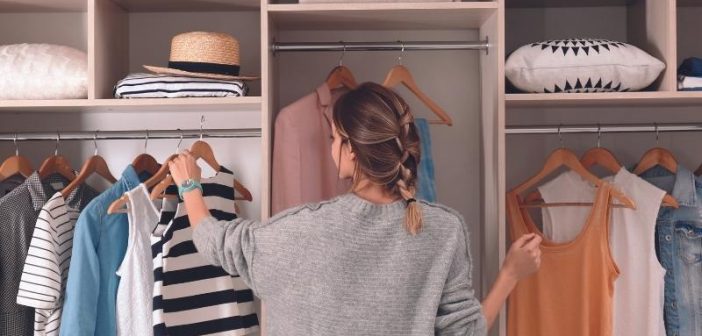We spoke to professional organising duo Claire Savage & Lisa Skinner from Order in the House to get the best insights on how to organise your wardrobe…
Spring brings with it the promise of new hope and many of us will seize the opportunity to break old habits and set ourselves some new goals to reinvigorate our lives over the months ahead. We press the reset button and with great intentions, we ditch those old ways and cultivate new ones. You can make a radical change this spring which is not only achievable but will have a huge impact on your life and, in Narnia fashion, it all begins in your wardrobe! The challenge lies, however, in changing your entire view of clothes, how you shop and what you wear. Are you ready to take a deep breath, open those wardrobe doors, take a look inside and ask yourself, how much of the contents do I actually wear? How easy is it to find what I’m looking for? How much of it can I even see?
Did you know that your cluttered wardrobe could be holding you back from making good decisions in life? It’s true! Former US President Barak Obama used to have his clothing for each day selected the night before to enable him to wake up less rushed and less stressed. ‘You’ll see I wear only grey or blue suits,’ Obama told Vanity Fair in 2012. ‘I’m trying to pare down decisions. I don’t want to make decisions about what I’m eating or wearing. Because I have too many other decisions to make.’ Whilst his selection was limited in nature imagine the exhaustion (decision fatigue) that could have ensued had Obama opened a wardrobe so full to the brim that he couldn’t even identify the items needed to form a complete outfit. And yet this is the daily routine for many of us, granted not all of us are leading a world superpower but regardless we’ve reached a point where we have so much stuff that we can no longer see the wood for the trees and that hinders and distracts us from the bigger decisions we have to make that day. How many times do we open those wardrobe doors, peek inside and declare we have nothing to wear?! And what do we do? Make a dash to the shops or hit the internet to consume yet more clothes merely adding to the problem.
A MINIMAL MAKEOVER
Some modern minimalists advocate for a capsule wardrobe of just 37 items, you shouldn’t get too hung up on the number of clothes but rather what the minimal amount is that you need for your lifestyle. We’re not telling you to get rid of everything but to clearly identify what you have and focus your decision-making energy. Your wardrobe should never be more than 80 per cent full. However, in order to achieve this, you must be prepared to declutter and commit to doing so on an ongoing basis. Nowadays, there are so many options for recycling old clothes, with big companies have recognised the potential to increase their sustainability rating through recycling initiatives. Indeed pre-loved clothes can be recycled via the H&M Garment Collection scheme, the Marks & Spencer Shwopping initiative or the Levi’s Blue Jeans Go Green, to name but a few – all of which offer a reward in return for your donation. With regards to kid’s clothing, the more sentimental pieces can be turned into mementoes such as teddies, while Boden kids’ clothes can be returned to the company to support British baby banks. And when it comes to shoes, Schuh will compensate customers for returning old shoes to their stores to be reused and recycled. Otherwise, you can simply donate your pre-loved clothing to charity shops or clothing banks or indeed sell them via eBay, Facebook Marketplace or Depop. You will have more success selling online if you sell items for the current season and keep out of season pieces for the appropriate time.
START SMALL
When starting to declutter your wardrobe we suggest you start small, maybe tackle the underwear first as it will likely prove easier to part with underwear than the bigger ticket items such as dresses or coats. By starting small you will ease yourself into the process and that should get you in the zone for clearing out before you come to the harder decisions. It’s helpful to start by deciding what you want to keep as opposed to what it is that you’re getting rid of. Marie Kondo suggests that you ask yourself – ‘Do I need it and does the piece of clothing spark joy?’ If it doesn’t spark joy it needs to go.
KEEP IT CURRENT
It’s always good to think about what you need for your current circumstances and current shape/size. Many of us have a tendency to hold on to items from a past life that we are no longer living, maybe it was a time of life that you’re nostalgic about and that is okay, but if the clothes are not being worn or if they do not fit they don’t need to be taking up space in your wardrobe. By all means keep those aspirational pieces that you plan to get back into someday, we all need that motivation, but keep them somewhere else, for the time being, the attic or even in some under bed storage. If you’re really tight for space rotate your seasonal wardrobe, vacuum pack last season’s items and store them elsewhere in your home until such time as they’re needed again.
STORAGE SOLUTIONS

SKUBB Box, set of 6, white €5. ikea.com








